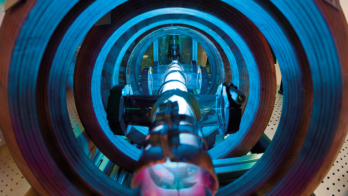By Alexander W Chao and Weiren Chou (eds.)
World Scientific
Hardback: £98
E-book: £74
Reviews of Accelerator Science and Technology is a journal series that began in 2008 with the stated aim “to provide readers with a comprehensive review of the driving and fascinating field of accelerator science and technology” – in a “journal of the highest quality”. It made an excellent start, with the first volume presenting the history of accelerators, followed by one that focused on medical applications. With one volume published a year, there are now five in the series, which appears to show no signs of failing in its original goals. Each has communicated a specific topic through the words of highly respected experts in articles that are well illustrated and presented. The books they form hold the promise of becoming an unrivalled encyclopaedia of accelerators.

This latest volume is no exception. It looks at the role of superconductivity in particle accelerators and how this intriguing phenomenon has been harnessed in the pursuit of ever-increasing beam energy or intensity. It also considers the application of superconducting technology beyond the realm of accelerators, for example in medical scanners and fusion devices. As well as containing much technical detail it is also full of fascinating facts.
Exactly 100 years ago, Heike Kamerlingh Onnes speculated that a 10 T superconducting magnet “ought not to be far away”. The first contributions to this volume, in particular, outline some of the steps to 10 T – and why it took longer than Onnes had originally hoped for the industrial-scale production of high-field superconducting magnets to become reality. A major problem lay in finding superconducting materials with physical properties that allow large-scale fabrication into wires. The first commercially produced wires were of niobium-zirconium, as used in early superconducting magnets for bubble chambers. However, this alloy was soon superceded by niobium-titanium (NbTi) – the material of choice in high-energy physics for the past 40 years, culminating today in the superconducting magnets for the LHC, as well as the huge toroidal and solenoidal magnets for the ATLAS and CMS detectors. Now, R&D effort is turning to Nb3Sn, which can allow higher magnetic fields, for example for the High Luminosity LHC project.
In this context, it is worth realizing that the biggest market for superconducting magnets is for nuclear magnetic-resonance spectroscopy – and it is here that a field as high as 23.5 T has been reached in a magnet based on Nb3Sn. There is also interest in high magnetic fields for magnetic resonance imaging (MRI) in medicine. In MRI the signal strength is related to the polarization of the protons in whatever is being scanned. Increasing the magnetic field from the 1.5 T that is currently used routinely to 10 T results in a polarization that is almost seven times higher, as well as improved signal-to-noise, leading to a clear improvement in image quality. Upcoming developments include 6 T magnets based on Nb3Sn.
The application of superconductivity in particle accelerators extends of course to the acceleration system, with the use of superconducting RF technology, first proposed in 1961. In this case, an important part of the R&D has focused on the physics and materials science of the surface – the surface resistance being a key parameter. So far there are no commercial applications for superconducting RF, but it has a role in many types of particle accelerators, from high-current storage rings at light sources to the high-energy machines of the future, such as the International Linear Collider (ILC).
Jefferson Lab’s Continuous Electron-Beam Accelerator Facility (CEBAF) is in a sense the “LHC” of superconducting RF, employing originally 360 five-cell 1.5 GHz cavities. It is currently undergoing an upgrade to 12 GeV with cavities that will operate at 19.2 MV/m. The European X-ray free-electron laser project, XFEL at DESY, will use 800 nine-cell 1.3 GHz cavities operating at more than 22 MV/m, but it would be dwarfed by an ILC with more than 15,000 cavities.
Besides the contributions on the major topics of superconducting magnets and RF, others are dedicated to cryogenic technology, industrialization and applications in medicine. In addition, following the journal’s tradition, there are articles that are not related to the overall theme but are of concern to the accelerator community worldwide. In this case, one article discusses the education and training of the next generation of accelerator physicists and engineers, while another reviews the history of the KEK laboratory in Japan. Altogether, this makes for more than a journal volume – in my opinion, it is a book, well worth reading.





